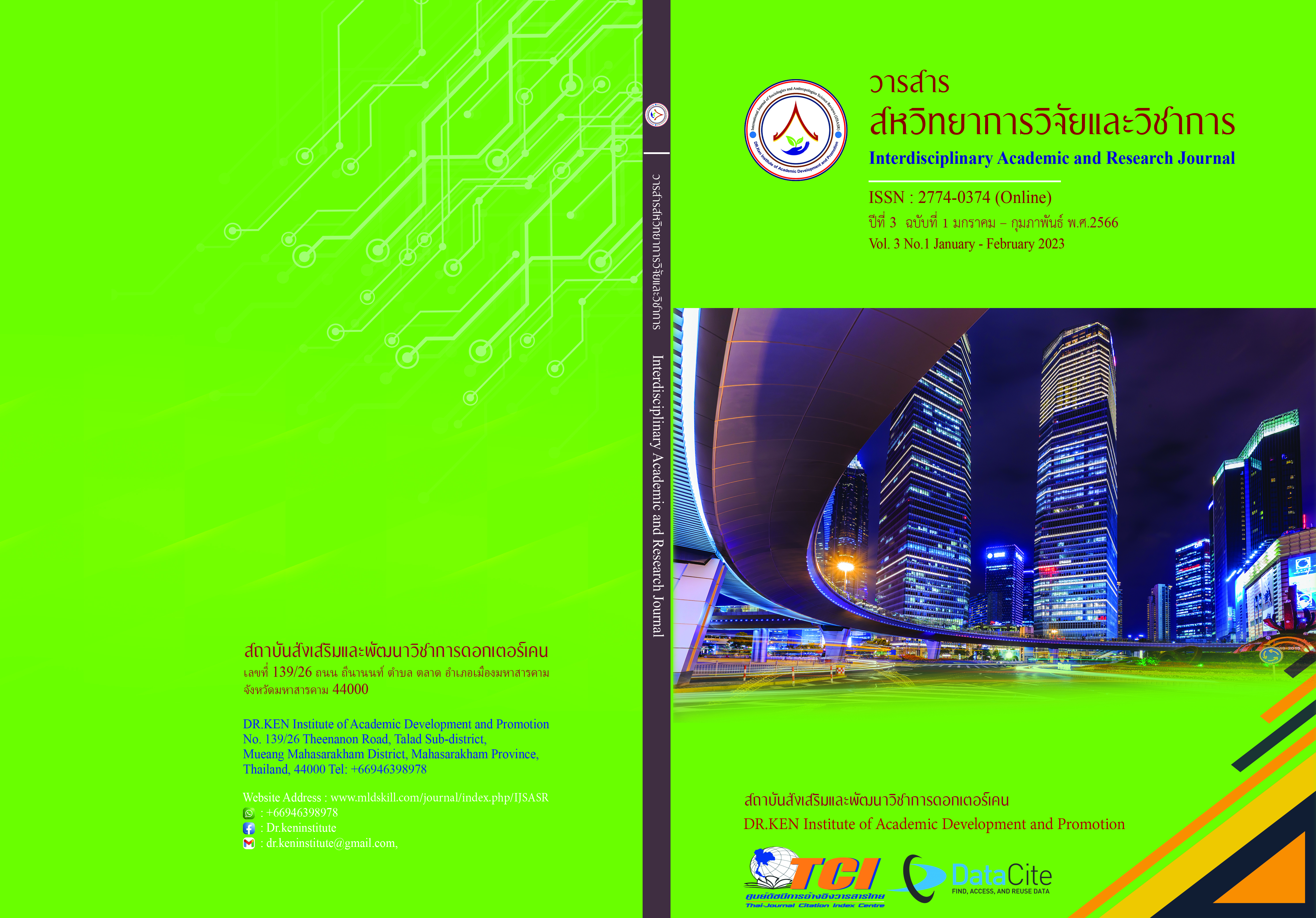A Comparative Study of Indicators of Fairness in Communities with Cultural Differences
DOI:
https://doi.org/10.14456/iarj.2023.1Keywords:
Comparative Study;, Indication of Fairness; , Cultural DifferencesAbstract
That it is a problem. Which is complex both in structure and behavior of people involved, as well as beliefs and cultures that affect inequality and fairness in society. This objective is to compare the indicators of fairness in communities that there are cultural differences.
Key informants were community residents in the households of Suan Pepper community. Suan Pepper Subdistrict Mueang Pathum Thani District and Bueng Thong Lang Subdistrict, Lam Luk Ka District, Pathum Thani Province, 30 people (15 people per community). Data collection included Documentary study, Rapid Rural Appraisal (RRA), Observation, In-dept interview, Small Group Discussion. The analysis of the data uses the Thematic Analysis method. The data analysis performed a logical analysis, a ranking analysis of frequency-based fairness indications repeated from the informant by coding for each and every subtext and using the data to verify the integrity of the data. Trust in the shared view (Shared Viewing) from the forum of small groups. The results showed that Indicators of fairness include (1) having regular consultation and being able to talk to each other, (2) having regular visits/relationships, (3) being able to work together. Be kind
to each other (4) Respect each other/spoken words (5) Encourage/help each other in difficult times (6) Regular consultation (7) Villagers love and unity (8) Villagers have the right The freedom to live without oppressing others has the right to equal use of public resources (9) to be able to talk to one another, (10) to respect each other, to listen to one another, and (11) to have leadership in charge. Pay attention to the people and provide information to the people thoroughly and accurately.
References
มูลนิธิธรรมรัฐเพื่อการพัฒนาสังคมและสิ่งแวดล้อม. (2560). คู่มือการจัดทำตัวชี้วัดความอยู่เย็นเป็นสุข ร่วมกันในสังคมไทย โครงการปรับปรุงดัชนีความอยู่เย็นเป็นสุขร่วมกันในสังคมไทย. กรุงเทพฯ : มูลนิธิธรรมรัฐเพื่อการพัฒนาสังคมและสิ่งแวดล้อม.
ราชกิจจานุเบกษา. (2560). รัฐธรรมนูญแห่งราชอาณาจักรไทย พุทธศักราช 2560. เล่ม 134 ตอนที่ 40 ก. : 14-15.
ราชกิจจานุเบกษา. (2561). ยุทธศาสตร์ชาติ พ.ศ.2561-2580. เล่ม 135 ตอนที่ 82 ก. : 38-40.
วนิดา ตุรงค์ฤทธิ์ชัย, กมลทิพย์ ขลังธรรมเนียมและ นพนัฐ จำปาเพศ. (2561). การพัฒนาระบบสวัสดิการสังคมสำหรับผู้สูงอายุด้อยโอกาสเพื่อลดความเหลื่อมล้ำทางสังคม. วารสารสังคมสงเคราะห์. 26 (1), 113-114.
วรธา มงคลสืบสกุล. (2565). การเข้าถึงบริการทางสาธารณสุขไทย: ภาพสะท้อนและความเหลื่อมล้ำของกลุ่มเปราะบางทางสังคม. วารสารมนุษยศาสตร์และสังคมศาสตร์ มหาวิทยาลัยเอเชียอาคเนย์. 6 (1), 55-69.
วันชัย ฝึกหัด,วงศกร เจียมเผ่า. (2560). ความคาดหวังของประชาชนต่อการปฏิบัติของเจ้าหน้าที่ตำรวจจราจร ในเขตสถานที่ตำรวจภูธรเมืองพิษณุโลก.การนำเสนอผลงานวิจัยระดับชาติ เครือข่ายบัณฑิตศึกษา มหาวิทยาลัยราชภัฏภาคเหนือครั้งที่ 17. 20 กรกฎาคม 2560 : มหาวิทยาลัยราชภัฏพิบูลสงคราม.
วิชา มหาคุณ, กฤษฎา แสงเจริญทรัพย์. (2565). การสร้างความเป็นธรรมทางสังคมโดยกระบวนการยุติธรรมชุมชน : บทเรียนจากต่างประเทศ. วารสารมหาจุฬานาครทรรศน์. 9 (2), 308-309.
สำนักงานสภาพัฒนาการเศรษฐกิจและสังคมแห่งชาติ. (2564). ร่างแผนพัฒนาเศรษฐกิจและสังคม แห่งชาติ ฉบับที่ 13 “พลิกโฉมประเทศไทยสู่ สังคมก้าวหน้า เศรษฐกิจสร้างมูลค่าอย่างยั่งยืน. กรุงเทพฯ สำนักงานสภาพัฒนาการเศรษฐกิจและสังคมแห่งชาติ.
เสกสรร ประเสริฐกุล, (2542). สารคดีคัดสรร พ.ศ. 2535 - 2540. กรุงเทพฯ : เคล็ดไทย
Downloads
Published
How to Cite
Issue
Section
License
Copyright (c) 2023 วุฒิชัย สายบุญจวง

This work is licensed under a Creative Commons Attribution-NonCommercial-NoDerivatives 4.0 International License.
Copyright on any article in the Interdisciplinary Academic and Research Journal is retained by the author(s) under the under the Creative Commons Attribution-NonCommercial-NoDerivatives 4.0 International License. Permission to use text, content, images, etc. of publication. Any user to read, download, copy, distribute, print, search, or link to the full texts of articles, crawl them for indexing, pass them as data to software, or use them for any other lawful purpose. But do not use it for commercial use or with the intent to benefit any business.
















.png)


